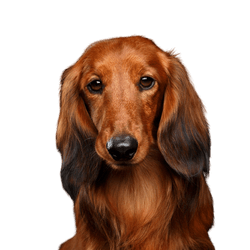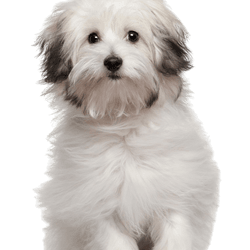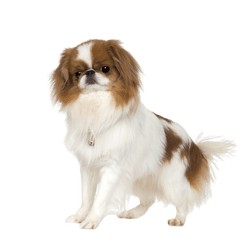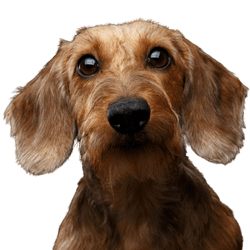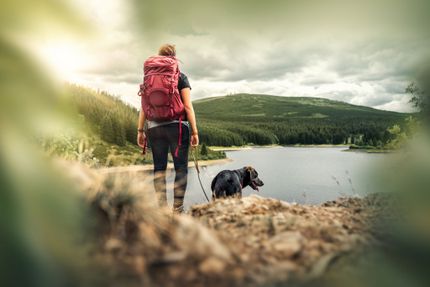
Dandie Dinmont Terrier Breed description: Character & Co
Dandie Dinmont Terrier
Facts & Origin
What is the origin of the Dandie Dinmont Terrier?
The Dandie Dinmont Terrier can be traced back to the 17th century as a distinct breed. The Scottish dog breed originated in the Cheviot Hills, which lie between England and Scotland. Its origin is attributed to the crossbreeding of a Welsh Beagle, an Otterhound, as well as an Old Scottish Rough-coated Terrier. Until the 18th century, he was often kept by tinkers and musicians. Farmers and landowners liked to use the dog breed to hunt hares, badgers, and otters. The Dandie Dinmont Terrier gained fame through the novel "Guy Mannering" published by Sir Walter Scott in 1814. The dog breed is listed by the FCI in Group 3 (Terriers) in Section 2 (Lowland Terriers) under Standard No. 168.


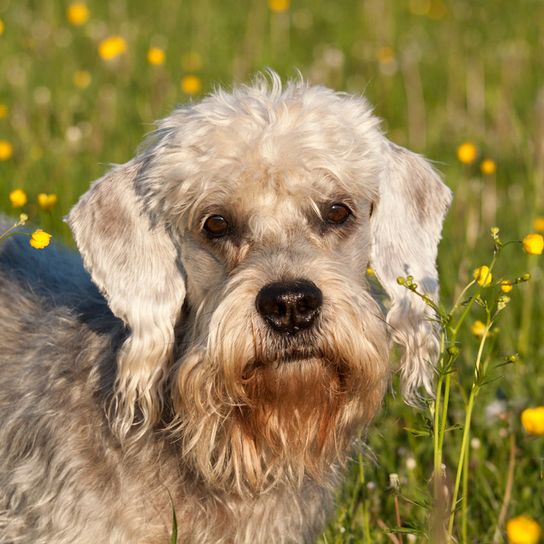

| Alternate Name | - |
| Origin | UK |
| Life expectancy | 9 - 15 years |
| Care requirements | high-maintenance |
| Activity level | low |
| FCI group | Small sized Terriers |
| AKC group | Terrier Group |
| KC group | Terrier Group |
Attitude, character and temperament of the breed
What are typical character traits of the Dandie Dinmont Terrier?
The Dandie Dinmont Terrier is considered to be courageous and eager to work. He is extremely intelligent, determined and persistent. Nevertheless, he is very affectionate, extremely loyal and usually in a good mood. He wants to be everywhere and is the ideal companion dog for adults. Towards strangers or children, however, he is rather sceptical or reserved. Towards other dogs the Dandie Dinmont is friendly and does not start fights. He is a fearless opponent when upset, but rarely barks without reason. Before acting or responding to commands, he seems to first consider whether obedience is worthwhile. Nevertheless, the Dandie Dinmont Terrier can be trained with patience and consistency.
Character
Usage

Health and breeding information
What are typical diseases of the Dandie Dinmont Terrier?
The Dandie Dinmont is prone to obesity and joint damage. Chondrodysplasia is manifested by impaired cartilage formation. This can prematurely terminate length growth on the limbs, which in turn can lead to herniated discs. However, genetic conditions such as hyperfunction of the adrenal cortex, hypothyroidism or cataracts are also possible.
Dandie Dinmont Terrier Breeding?
The Dandie Dinmont Terrier is not a dog breed that is widely available. Therefore, when buying a puppy, you should take a close look at the kennel to ensure that you get a lot of enjoyment from your dog. You can find an overview of reputable breeders of Dandie Dinmont Terriers on the VDH website.


What are the breed characteristics of the Dandie Dinmont Terrier?
- Head: strong, large, fitting to the size.
- Neck: very muscular, strong and well developed
- Shoulder height: 24-28 cm
- Body: 2.5 cm shorter in length than twice the shoulder height
- Tail: 20-25 cm, rather thick at the base of the tail.
- Gait: strong, forward, light step
- Ideal weight in working condition: 8-11 kg
Appearance and coat of the Dandie Dinmont Terrier
The distinctive head of the Dandie Dinmont Terrier is framed by silky hair. The elongated, low-set, and weasel-shaped body is complemented by an intelligent and understanding eye expression. The weather-resistant coat consists of a soft undercoat and a long, harsh outer coat. The strong legs are short, with the forelegs having about 5 cm of feathering. The top of the tail is also covered with wiry hair, while the underside is abundantly feathered with softer hair. Possible coat colours are
- pepper-coloured body (blue-black to light silver-grey shading) with silver-white mop of hair,
- mustard body (reddish-brown to beige shading) with cream mop of hair.
How big does the Dandie Dinmont Terrier grow?
The Dandie Dinmont Terrier can reach a wrist height of 22 to 28 inches.
How much does a Dandie Dinmont Terrier weigh?
The optimal weight for a Dandie Dinmont Terrier is 8 to 11 kg.
How old does a Dandie Dinmont Terrier become?
With proper care and nutrition, the Dandie Dinmont Terrier can live from 9 to 15 years.
| Fur length | medium |
| Fur | wavy |
| Ear shape | Floppy Ear |
| Tail | fanned out |
| Anatomy | hefty |
| Size ♀ | 20 - 28 cm |
| Weight ♀ | 7 - 10 kg |
| Size ♂ | 20 - 28 cm |
| Weight ♂ | 8 - 11 kg |
| Suitable For | - |
Colors



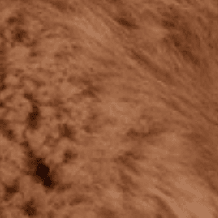
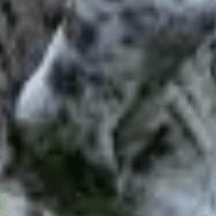
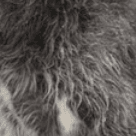
Known Diseases
Disc problems
Herniated disc in dogs (discopathy). Herniated discs or dachshund paralysis cause dogs severe pain.
Cataract
Cataracts are still one of the most common causes of blindness, even in dogs.
Damage to the gait
Often seen in severely overweight dogs and heavy breeds.
Hypothyroidism
Most often, dogs get sick in middle age. Causes of hypothyroidism. Several causes of hypothyroidism are known.
Overweight
Often, unfortunately, the dogs very much under excess weight. But the dogs themselves are never to blame!
Other small dogs
Useful Articles

You can find articles that might interest you in the dogbible blog to match your favorite breed.
Visit our magazineto stay up to date on dog trends.
To find out more, view our Privacy Policy
Find here the breed that suits you and find out what character traits it has. Here you can also learn more about the origin, size and weight of your favorite breeds.
Matching your favorite breed, you'll find articles that might interest you on the dogbible dog blog.
Fleas dog - What helps preventively
7 tips for the mental workout of the dog







